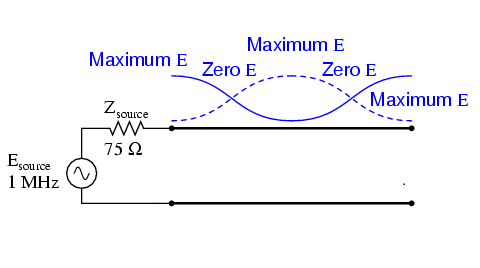I am currently learning about transmission lines form an online book hosted by a website called “All About Circuits”. If anyone is interested, the particular chapter I am currently reading can be found here: http://www.allaboutcircuits.com/vol_2/chpt_14/6.html.
Basically, the book talks about having a circuit with a transmission line that looks like this:

The transmission line is supposed to be long enough so that:
- At 250 kHz, the line's length is precisely right for 1/4 wavelength.
- At 500 kHz, the line's length is precisely right for 1/2 wavelength.
- At 750 kHz, the line's length is precisely right for 3/4 wavelength.
- At 1000 kHz, the line's length is precisely right for 1 wavelength.
The images below show that standing wave graphically depicted with the frequencies mentioned above.
At 250 kHz, 1/4 wavelength:

At 500 kHz, 1/2 wavelength:

At 750 kHz, 3/4 wavelength:

At 1000 kHz, 1 wavelength:

If you look at the standing wave for the mentioned frequencies, you will notice that the load end of the transmission line always has a standing wave antinode. I can understand this because the line is open so in my mind this makes sense.
What I don’t understand is why (depending on the frequency), we sometimes get a node and sometime an antinode on the source side of the transmission line. I don’t understand this because both the source and load sides are supposed to be endpoints which should mean that they should always be nodes or always be antinodes but not vary (at least that is my understanding).
Nevertheless, I am obviously missing something here so I was hoping someone could help me out and clarify what is going on here.
Thank you.
